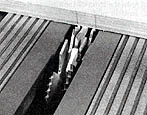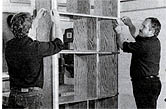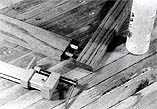|
|||
Articles and Projects
| Back to Article and Project Index | |
|
Bookcase Project Details, Drawings & Layouts mentioned in this article can be found Here
This bookcase is constructed in five separate units: the carcass or frame which is all A2, 3/4" red oak plywood, the face frame which is solid 3/4" red oak, the molding, the door, and the TV shelf and hardware. This bookcase was built on the Shopsmith Mark V Model 510. The extra large table system and extension table system is very handy when working with such large pieces of wood. The special accessories used are the Dado Package for 510 and the Shaper Package. The Shopsmith 4" Jointer was also used to smooth the solid oak edges. 1. Cut the plywood to size. Begin by ripping the plywood lengthwise into strips 15 3/4" wide. The extension table on the Mark V helps support the heavy plywood for these long cuts, yet even with this support, you should enlist the assistance of a helper or use a roller stand and rear support table. After ripping the plywood, crosscut it to length. Follow the cutting instructions in the list of materials.
Be sure the machine is unplugged for your set-up. Carefully line up the marks you made on the edge of the plywood with the Dado Blade. Then crosscut your dados with one edge flat against your miter gauge. This is a tricky procedure because furniture-grade oak plywood has a very thin veneer on the outside that is susceptible to splitting if it is not cut properly. Set your speed dial to "R". Make a cut that is only as deep as the veneer thickness on the plywood. Then lower the table to final depth and make a second cut at the same place. The Stop Collars (from the lathe Tailstock) mounted on the table posts will set the final Dado depth of cut. The large table system on the Mark V 510 allows you to crosscut or Dado wide pieces with ease. If you are working with the Mark V Model 500, use the Front Table Extension to help support wide pieces as you crosscut and Dado. The Rear Support Table, Roller Stands, a Miter Gauge Extension or a Cross-Cut Sliding table will also help provide additional stability. Now mark and cut the other dados on shelf divider (K), and fixed shelves (G, N). Mark the dados on shelf divider (J). The dados on the button will be on both sides of the piece, so mark them just 1/4" deep. Mark the Dado in the center of the top (B), but not the ones on the ends. Cut these dados. 3. Other dados and rabbets. Now that you have completed all the 3/4" dados, change the width of your blade to 3/8". As you can see from the illustration of this Dado-Rabbet joint, the dados on the ends of the top (B) are 3/8" wide, 3/8" deep, and 3/8" from the end of the board. Mark and cut these dados. The L-shaped cuts on the top of sides (A, O) are rabbets. Use the same 3/8" adjustment on your Dado blade to cut them 3/8" deep right on the ends of the boards. Notice that these cuts are on the opposite side of the previously cut dados (A, O). 4. Drillholes for brackets. Brown plastic shelf brackets are used here for the adjustable shelves. They are available in hardware stores and fit in 1/4" holes. Mark and drill you holes in the right side (O), and shelf dividers (J, K). These holes are set in two inches from the front and back, at 2" intervals up and down. 5. Finishing. At this stage, the finish is applied to the plywood. The reason for finishing the unassembled boards is so you can work on them while they lie flat and so the finish will not run. Put masking tape on the ends of the boards that will be housed inside dados. The joints will glue together better on bare wood.
Assemble the bookcase dry first to be sure all the pieces fit. Set your clamps and check for square. Then re-assemble it with glue. Leave out your adjustable shelves (F, H, M) and TV shelf (P) during the glue up. 7. Begin the face frame. Cut the left side (Q); right side (R), top (S), and bottom (T). Do not cut the narrower, 3/4" molding strips at this time. As you rip the long 96" pieces, use a helper or roller stand to hold them level during the cuts. 8. Joint the edges. Run the edges of your face frame pieces over the Jointer to square them up and smooth them out. This will you give a much smoother edge than you get from the table saw. 9. Drill dowel holes. Set up your Mark V for the horizontal-boring mode. Drill 3/8" holes in the top and bottom edges of the long, 96" side pieces (Q, R). Each joint will have two dowels. Measure the spacing on them so they will fit into the ends of the 3" bottom piece (T) and the 4" top piece (S). Drill the holes as shown in illustration.
NOTE: If you prefer, biscuit joints the Biscuit Joiner Attachment could be substituted for the dowel joints suggested here. 11. Glue up the outer frame. Glue the 3/8" dowels and edges of the outer frame pieces where they will join. Clamp them together and allow the glue to dry. 12. Finish the frame. Follow the same procedures you followed earlier. Finish all additional pieces similarly just prior to assembling them. 13. Attach the face frame. Use glue and small finishing nails (2" long) and attach the outer face frame to the carcass. Drill pilot holes into the frame so that the solid oak will not split. 14. Shape the molding. Use the Shopsmith Shaper Package your Mark V with a 1/2" Bead & Quarter Round Cutter. Round the edge of a long piece of oak with the Quarter Round side of the cutter. Then turn the piece over and round the other corner of the same edge. After you have completed shaping the edge, rip it on the table saw so that it is 3/4" wide. You now have half-round molding. Shape and cut enough molding strips to face all of your shelves and shelf dividers, and both the front and sides of the TV shelf (P). The secret to shaping is to take shallow cuts, follow all the safety guidelines, and experiment with some scrap wood to test the results. Shaping is also mch easier with the DC3300 Dust Collection System, which disposes of the chips just as they are being made. 15. Size the molding. Measure the shelf lengths after the outer frame is attached and cut your 3/4" molding strips to length. Chamfer the ends of the molding. Set up your disc sander and tilt the table to 45°. Lay a molding strip upside down against your miter gauge and chamfer the end to add a little accent if you wish. Since the TV shelf (P) will have molding on the sides as well as the front, the ends of the molding will have to be beveled at 45° to "frame" the shelf on the front corners. Do not chamfer the ends of the TV shelf molding. 16. Attach the molding. After applying the finish to the molding, nail the molding onto the front of the shelves. Remember to drill pilot holes. Inset all of your finishing nails with a punch. Then cover the holes with wood patch that is mixed with stain. 17. TV shelf hardware. A combination shelf slide and lazy-susan called a "TV Extension Slide" will hold your TV shelf (P), and eventually your TV set. Attach the slide to the TV shelf (P) and fixed shelf (N) with #8 3/4" screws.
Then flip the piece over and shape a corner on the opposite edge. After the piece is shaped, rip one side on your table saw 3" wide and the other side 1" wide. (The ripping is done after the shaping because shaping is safer with wide pieces.) Repeat this process so that you will have two 3" wide and two 1" wide molding strips, each 48" long. All of the molding pieces must be measured precisely and cut with 45° bevels on the front corners. To avoid mistakes, we suggest clamping each piece in place at the top of the bookcase and checking precisely where the bevel cuts should go. Glue up each 3" and 1" molding combination together. Line up the beveled edges, and then clamp them while the glue dries. Clamp each 1" and 3" molding combination to the top of the bookcase. Line up the corners carefully. Then drill pilot holes from the inside of the bookcase and screw in #8 1 1/4" screws to secure the crown molding.
This cutter kit takes some practice to perfect, so plan to spend time experimenting on scrap wood before making the door. It is a challenge to work out, but the appearance of a nice looking, door makes it worth while. Slide a 1/4" oak plywood panel into the frame pieces. Glue and clamp the pieces together - no dowels are necessary because of the way the rails and stiles fit together. Apply your finish, add hinges, and attach the door to the bookcase. Your bookcase is now finished. Go celebrate. You deserve it. Details, Drawings & Layouts mentioned in this article can be found Here
LIST OF MATERIALS Carcass: 3/4" A2 red oak plywood (two 4" x 8" sheets). Optional TV Shelf requires another piece.
Face Frame: Red Oak 96 x 12 x 3/4
Door: Red Oak 3/4 x 9 x 48
Crown
Molding: Red Oak 48 x 10 x 3/4 Cut to size after shaping.
Cutting Instructions : Rip both sheets of plywood into 15 3/4" strips, 96" long. On the first 96" length, cut pieces B, F and I. On the second length, cut E, J and K. On the third length cut C, G and L. On the fourth length cut D, H, M and N. The two remaining 96" lengths will be for the sides (A, O).
|
||||||||||||||||||||||||||||||||||||||||||||||||||||||||||||||||||||||||||||||||||||||||||||||||||||||||||||||||






